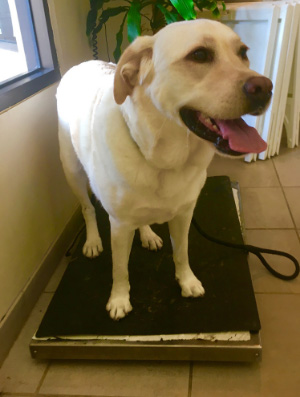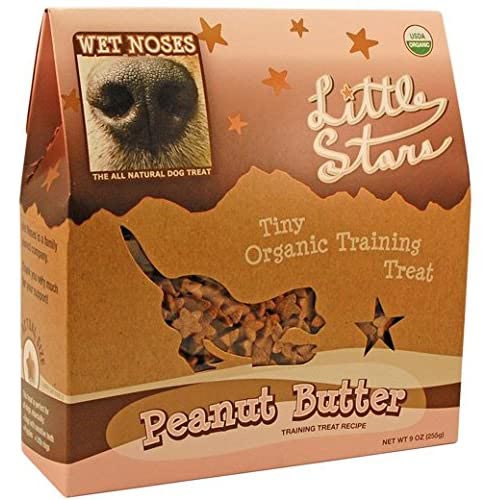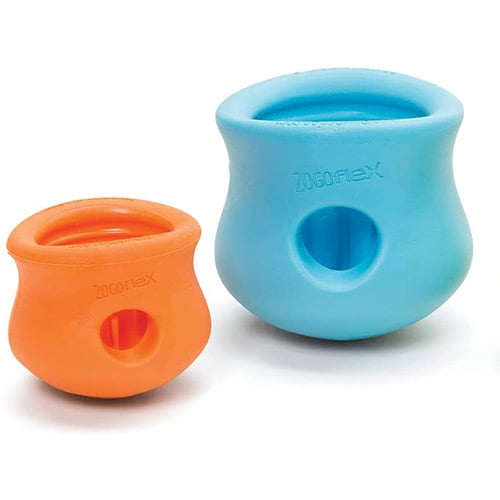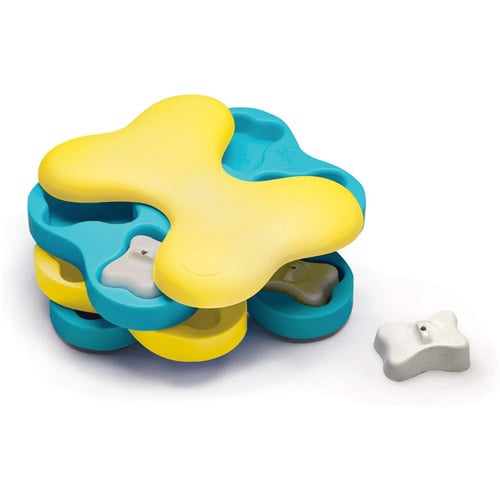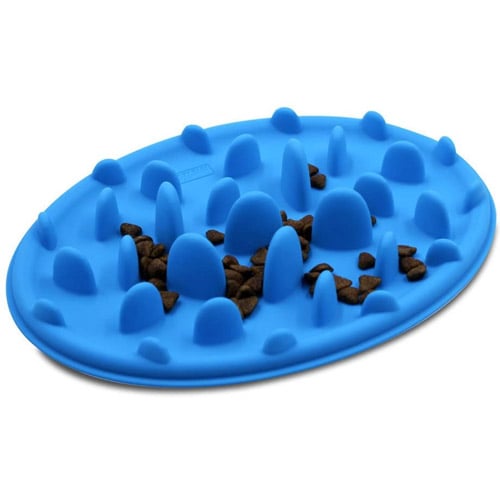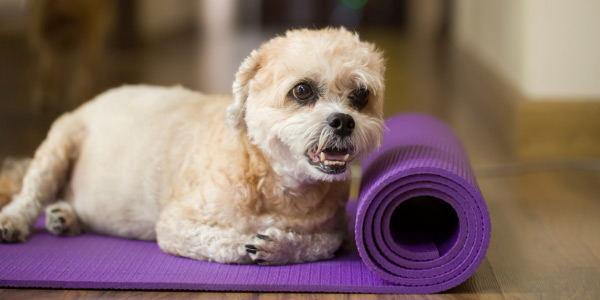
As humans, we associate food with love and happiness. Who doesn’t smile after eating a donut or when someone brings them a box of chocolates?
Since we want to show our dogs that we love them and want them to be happy, we FEED them. We give them extra treats and might even share our human food to show love.
Their positive response to all this makes us want to do it all the more! No one is immune to those sweet eyes and wagging tails.
Unfortunately, this type of love ends up as excess calories, which causes weight gain for our dogs.
A better way to show our love for our dogs is to control feedings, make sure they get enough exercise, monitor how many treats they get every day, and incorporate real-life rewards. That way, we're cutting back on excess calories and keeping our dogs healthy and happy!
Check out these eight ideas for trimming down your pooch.
1. Pay Attention to How Much You're Feeding Your Pet
You can help your dog by getting a set of dry measuring cups specifically for your pet’s food.
They’re inexpensive and easy to find. Or you can make feeding even more precise, without spending much more money, by getting a small kitchen scale to weigh the amount of food you’re feeding your pet.
Use Your Pet Food Scoop Correctly
There are fine lines on the inside of most pet food scoops that indicate where the 1-cup and 2-cup measurements are. If your scoop doesn't have these lines, stop using it and start using proper measuring cups!
Avoid adding “just a bit” more food above the measurement lines. Those little bits add up over time, especially for smaller pets under 25 lbs.
Not sure how much food your dog should be eating every day? Read more in this article about "How Much and How Often You Should Feed Your Dog."
2. Talk with Your Veterinarian about Your Pet’s Weight
Each year (or every 6 months for senior pets) at your pet's wellness visit, ask your veterinarian to evaluate your pet’s weight and body condition. Ask them if your dog is “just right,” too high, or even too low.
Here's a chart developed by Nestlé Purina that many veterinarians use when evaluating a dog's body condition:
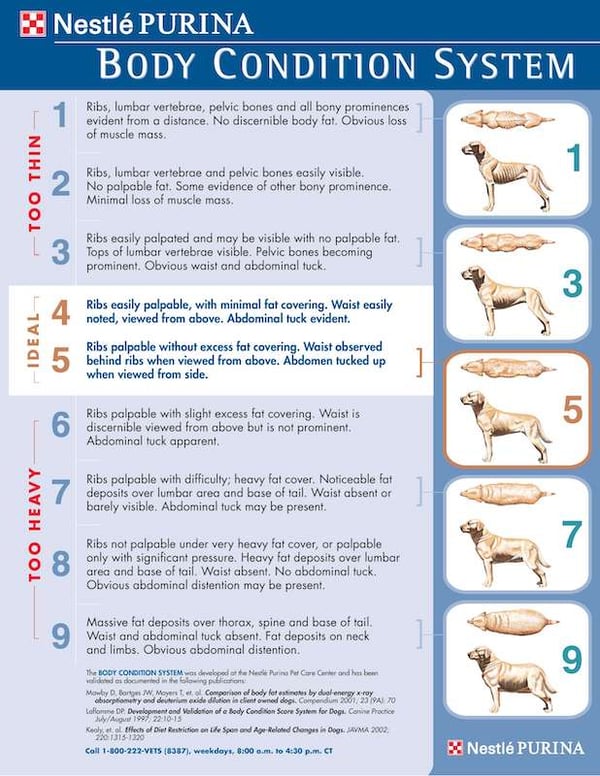
Once you know where your pet falls on the body condition scale and the regular scale, you and your veterinarian can come up with a plan to either keep your pet at their ideal body condition and weight or to help get them there.
Knowing what to aim for is very helpful.
PRO TIP: Before going to your dog's wellness visits, write down the brand and formulation of the foods you're feeding your dog, as well as the amount you feed. That way, when your vet asks, you're prepared and can get the most out of your pet's visit.
You can also take a picture of the front and back of your dog's bag of kibble or can of food to save a piece of paper, and also do the same for any treats you regularly give your pup.
3. Weigh Your Dog Regularly
I always recommended to my clients to regularly bring their pet into the office just to weigh them. Many pet stores also have a pet scale available for dog owners to use in between clinic visits.
I have found that regularly tracking a pet’s weight, rather than just at yearly check-ups, helps owners notice the slight changes in weight that might be hard to see.
It is easy not to notice a few pounds of weight gain, but after a while, those few pounds start adding up.
It’s easier to be proactive about weight gain if you know your pet’s ideal weight for their age, breed, and size, and can frequently check what they weigh.
How to Weigh Your Dog
Many dogs and cats (and humans) don’t love getting on a scale. Here are a couple of tips to get your pet’s weight:
-
If you know your weight, stand on your scale with your pet and subtract your weight from the total.
-
Weigh your pet inside their carrier, subtracting the weight of the empty carrier from the total.
-
Teach your dog how to stand-stay at home, and then practice this behavior on a pet scale.
-
Teach your dog how to “touch” or target your hand and use this behavior as a way to guide them onto the scale and keep them still.
-
Place a towel or non-skid mat on the scale, make sure it’s reset to “0,” and then have your pet step on. Often, simply changing the surface of the scale helps pets feel like they have better footing, encouraging them to stay on longer.
4. Monitor Your Dog’s Treat Intake
Do you give your dog any treats? Our pets care most about getting the treat and positive feedback from you — they don’t necessarily care how big the treat is.
Many dog training treats are made for medium to large-sized dogs, and a small dog can consume lots of calories quickly while chowing those down. Consider breaking those treats in half or smaller, or switch to low-calorie treats.
For example, you can cut Zuke's Mini Treats in half (as seen in the photo below), or even into quarters. This is perfect for when you need to use a lot of treats, such as training classes.
One of the easiest ways to cut treat calories is to use a portion of your pet’s regular food as their treats.
If you feed your dog wet food, simply take a portion of their daily amount and use a squeezable food tube to make it easy to use as a treat without getting your fingers messy.
Save the higher-value (and higher-calorie) treats for when you’re training around distractions!
Check out "What Kind of Treats Should You Use to Train Your Dog" for more tips on when to use high-value treats.
Cutting up treats makes them last longer, which saves you money! In the eyes of your dog, 1/2 a treat or a whole treat is all the same to them!
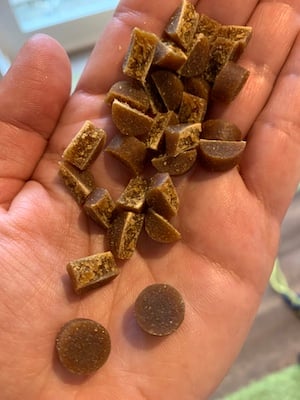
Or use extra tiny treats for training if you don't want to spend the time cutting up treats, such as Wet Noses Little Stars Treats.
How many treats can you give your dog? Ideally, treats should make up only 10% of your dog's daily calorie intake. See this article to learn more about dog treats and how to calculate how many treats you can give your dog.
Replace some or all of your pet’s higher-calorie treats with dog-safe fruits and vegetables, such as carrots (use caution not to overdo carrots – I have had patients get heavier on them!), green beans, or apples — no apple seeds, though.
Get more ideas for healthy dog treats in "Choosing the Best Dog Treats."
Do you love to bake? You can make your own higher-value dehydrated chicken, beef, or liver treats using a dehydrator or baking treats in the oven. Need some inspiration? Here are three homemade dog treat recipes formulated by a veterinarian for you to try:
- Homemade High-Value Dog Treats
- Homemade Fluffernutter Kisses Dog Treats
- Homemade Blueberry Meringue Kisses Dog Treats
5. Increase Physical Exercise for Your Dog
Take your dog for more frequent or longer walks, or get them into a new sport like agility, nose work, or another. If the weather isn't the best for outdoor exercise, incorporate fun indoor activities like hide-and-seek or setting up an indoor agility course.
You can also do basic canine fitness exercises to increase balance and muscle strength.
Training your dog to use an indoor dog treadmill can also make exercise easier and more consistent. Watch this Yappy Hour for some fun indoor activities you can do with your dog to keep them active.
Please remember, just like we can’t go out and run a marathon without conditioning our bodies, neither can our dogs. Plus, a lack of physical conditioning can create an increased risk for injury and arthritis.
Taking it slow is especially important for obese or senior dogs and those with health issues. Consult with your veterinarian as to the best way to start and continue an exercise routine. Remember, slow and steady wins the race!
6. Use Slow-Feeders or Interactive Food Puzzles
Slow down the rate of your pet's eating to help them feel full faster by skipping the regular bowl and feeding them with a puzzle or interactive toy.
Another way you can slow down their eating is to add some water to their food. See more of our favorite interactive dog food puzzles here.
PRO TIP: You can stuff a Toppl with both wet and dry food or link the two sizes together to make a dry food puzzle ball.
7. Monitor for Medical Problems that Contribute to Pet Weight Gain
Talk to your veterinarian to see if there might be a medical problem that could be contributing to your pet’s excessive weight (such as a low-functioning thyroid, overactive adrenal gland, a buildup of fluid, or one of any other number of possible underlying conditions).
If your dog gets the all-clear, talk to them about a safe and effective weight reduction plan. Weight loss in pets should be slow and steady to be safe and effective.
Typically, cats and dogs should lose no more than 1–2% of their body weight each week.
8. Don’t Free Feed Your Pet
If your pet is a "grazer" (they don't eat all their food at once and eat slowly throughout the day), you still need to properly measure out their food to ensure proper nutrition and the correct amount of calories each day.
Don't just keep arbitrarily filling their bowl.
"Free feeding" isn't just a big contributor to the pet overweight and obesity epidemic; it also prevents you from picking up on early signs of pain and other problems, deprives your pets of an opportunity for mental stimulation and enrichment, and can make potty training much more difficult.
Read our Think Twice Before Letting Your Dog or Cat Free Feed article for more on this topic.
Also, leaving food to sit out is not ideal. The food can get stale, making your pet not want to eat it. Or if it gets wet, it can mold, which can then make your dog sick if they eat it.
How to Manage Your Dog's Calorie Reduction
Dealing With a 'Hangry' Dog
There are prescription diets your veterinarian can recommend to help your pet feel fuller on less food, so they don’t feel as "hangry" and beg. Remember, never suddenly change your dog’s diet.
Gradually, over a 7–day period, switch from the old diet to the new diet. Read more about how to switch your dog's food here.
If your pet is on a specialty diet, you can add some Psyllium husks. For dogs, add about a ½ tsp per 10 pounds twice a day to their meal. Do not go over 2 TBSP in a day. Monitor their stool closely.
Also, when adding fiber to your pet’s diet, you MUST be sure they have access to plenty of water. One easy way to do this is by adding some water to their dry food when mixing in the fiber.
This has two benefits — it causes them to eat more slowly (allowing the body to recognize feeling full), and it helps increase their water intake.
How Quickly Should I Cut Back My Dog's Food
I don’t know about you, but I can never survive a diet when I have to suddenly and drastically cut back. Your dog can’t either! I recommend gradually cutting back small amounts of food per feeding until the ideal portion size is reached.
For example, if you have a small breed dog, cut back a ¼ to a ½ tsp per meal. For medium to large breeds, you can start with a ½ to 1 TBSP per meal. Slow and steady!
What Rate of Weight Loss is Ideal for Dogs
Your dog can safely lose 3–5% of their body weight per month. Generally, you can expect your pet to reach their ideal body weight in 6 to 8 months. If they are not progressing as they should, changes are needed.
Your veterinarian can help you determine the number of pounds per month your dog can and should lose.
Remember — we are all in this together! Your veterinarian is a valuable resource who can answer questions and guide you through this process of your dog's weight loss and control. Patience and consistency are the keys to success.


